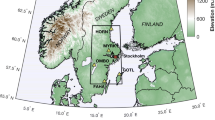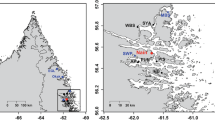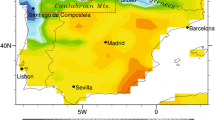Abstract
At present the most powerful tree-ring based climate reconstructions use high numbers of growth proxy series (ring width and density) to produce spatially smoothed estimates, such as average Northern Hemisphere summer temperatures. These single parameter reconstructions might be supplemented with regional climate reconstructions capable of capturing variability in more than one climate variable without lower replication compromising statistical quality, if multiple tree ring proxies were used. Pinus sylvestris and Pinus uncinata latewood density, width and δ13C series are presented from two sites in the French subalpine zone, east of Briançon. Where two proxies have the same dominant climate control their combination enhances that signal. Where proxies differ in dominant controlling climate variable, combining series allows access to bi-variable calibrations. Using this approach, multi-proxy reconstructions of both temperature and precipitation would better reflect complex synoptic variability in climate on spatially useful scales.
Similar content being viewed by others
References
Barclay, D. J., Wiles, G. C., and Calkin, P. E.: 1999, ‘A 1119-year tree-ring-width chronology from western Prince William Sound, southern Alaska,’ The Holocene 9(1), 79–84.
Beniston, M. and Jungo, P.: 2002, ‘Shifts in the distributions of pressure, temperature and moisture in the alpine region in response to the behavior of the North Atlantic Oscillation,’ Theor. and Appl. Clim. 71, 29–42.
Birks, H. J. B.: 1995, ‘Quantitative palaeoenvironmental reconstructions,’ in Maddy, D. and Brew, J. S. (eds.), Statistical Modelling of Quaternary Environmental Data. Technical Guide 5, Quaternary Research Association., Cambridge, pp.161–254.
Briffa, K. R., Bartholin, T. S., Eckstein, D., Jones, P. D., Karlén, W., Schweingruber, F. H., and Zetterberg, P.: 1990, ‘A 1,400-year tree-ring record of summer temperatures in Fennoscandia.’
Briffa, K. R. and Jones, P. D.: 1990, ‘Basic chronology statistics and assessment,’ in Cook, E.R and Kairiukstis, L.A (eds.), Methods of Dendrochronology: Applications in the Environmental Sciences. International Institute for Applied Systems Analysis, Kluwer Academic Publishers, Boston, pp. 137–152.
Briffa, K. R., Osborn, T. J., Schweingruber, F. H., Harris, I. C., Jones, P. D., Shiyatov, S. G., and Vaganov, E. A.: 2001, ‘Low-frequency temperature variations from a northern tree-ring density network,’ Journal of Geophysical Research 106(D3), 2929–2941.
Casty, C., Wanner, H., Luterbacher, J., Esper, J., and Boehm, R.,: 2005, ‘Temperature and precipitation variability in the European Alps since 1500,’ International Journal of Climatology, in press.
Cook, E. R.: 1985, ‘A Time Series Approach to Tree-Ring Standardization,’ PhD Dissertation, University of Arizona, Tucson, AZ, USA.
Cook, E. R. and Kairiukstis, L. A., (eds.): 1990, Methods of dendrochronology – Applications in the environmental sciences, Kluwer Academic Publishers, Dordrecht, The Netherlands, pp. 394.
Edouard, J.-L., Denelle, N., Gadbin-Henry, C., Guibal, F., Nicault, A., Rathgeber, C., Tessier, L., and Thomas, A.: 1999, ‘Dendrochronological calibration of tree-ring growth and climatic relationships at the timberline in the French Alps,’ in Hicks, S., Jalkanen, R., Aalto, T., McCarroll, D., Gagen, M., and Pettigrew, E. (eds.), Forest Response to Environmental Stress at Timberlines. Sensitivity of Northern, Alpine and Mediterranean forest limits to climate (final Report of EU project ENV4-CT95-0063), Thule Institute, University of Oulu, Finland, pp. 71–87.
Farquhar, G. D., Ehleringer, J. R., and Hubick, K. T.: 1989, ‘Carbon isotope discrimination and photosynthesis,’ Annual Review of Plant Physiology 40, 503–537.
Fauquette, S. and Talon, B.: 1995, ‘Forest history and timberline fluctuations in the region of Briançon: Lac de Cristol (Hautes-Alpes, France)’ Palaeontology and Palaeobotany Series ii, 321, 255–262.
Friedli, H., Lotscher, H., Oeschger, H., Siegenthaler, U., and Stauffer, B.: 1986, ‘Ice core record of the 13C/12C ratio of atmospheric CO2 in the past two centuries,’ Nature 324, 237–238.
Fritts, H. C.: 1976, Tree-Rings and Climate, Academic Press, New York, p.176.
Gagen, M., McCarroll, D., and Edouard, J.-L.: 2004, ‘The effect of site conditions on pine treering width, density and δ < eqid1 > 13C series,’ Arctic, Antarctic and Alpine Research 36(2), 166–171.
Grissino-Mayer, H. D.: 1996, ‘A 2129-year reconstruction of precipitaiton for northwestern New Mexico, USA,’ in Dean J. S., Meko, D. M., and Swetnam, T. W. (eds.), Tree-rings, Environment and Humanity: Radiocarbon, University of Arizona Press, Tucson, pp. 191–204.
Hemming, D. L., Switsur, V. R., Waterhouse, J. S., Heaton, T. H. E., and Carter, C.: 1998, ‘Climate variation and the stable carbon isotope composition of tree-ring cellulose: An intercomparison of Quercus robur, Fagus sylvatica and Pinus sylvestris,’ Tellus 50B, 25–33.
Hoper, S. T., McCormac, F. G., Hogg, A. G., Higham, T. F. G., and Head, M. J.: 1998, ‘Evaluation of wood pretreatments on oak and cedar,’ Radiocarbon 40, 45–50.
Keller, T., Guiot, J., and Tessier, L.: 1997, ‘Climatic effects of atmospheric carbon dioxide doubling on radial tree growth in south eastern France,’ Journal of Biogeography 24, 857–864.
Leavitt, S. W.: 2002, ‘Prospects for reconstruction of seasonal environment from tree-ring δ < eqid2 > 13C in subalpine spruces (Lötschental/Swiss Alps) – a case study with respect to altitude, exposure and soil moisture,’ Tellus 53B, 593–614.
Wigley, T. M. L., Briffa, K. R., and Jones, P. D.: 1984, ‘On the average value of correlated time series, with applications in dendroclimatology and hydrometeorology,’ Journal of Climate and Applied Meteorology 23, 201–213.
Wilson, A. T. and Grinsted, M. J.: 1977, ‘12C/13C in cellulose and lignin as palaeothermometers,’ Nature 265, 133–135.
Author information
Authors and Affiliations
Corresponding author
Rights and permissions
About this article
Cite this article
Gagen, M., McCarroll, D. & Edouard, JL. Combining Ring Width, Density and Stable Carbon Isotope Proxies to Enhance the Climate Signal in Tree-Rings: An Example from the Southern French Alps. Climatic Change 78, 363–379 (2006). https://doi.org/10.1007/s10584-006-9097-3
Received:
Accepted:
Published:
Issue Date:
DOI: https://doi.org/10.1007/s10584-006-9097-3




